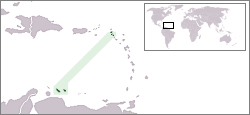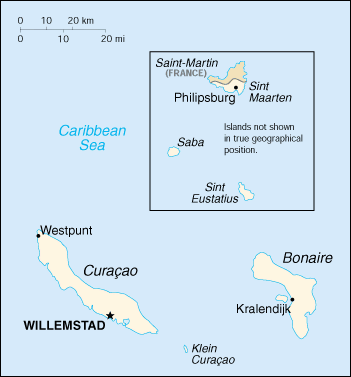Netherlands Antilles
|
|
The Netherlands Antilles (Dutch: Nederlandse Antillen), previously known as the Netherlands West Indies, are part of the Lesser Antilles and consist of two groups of islands in the Caribbean Sea that form an autonomous part of the Kingdom of the Netherlands (none of the other Antilles use this term in their name). The islands' economy is dependent mostly upon tourism and oil, though a large amount of money is also made through illegal drug trafficking.
| ||||
| National motto: Libertate unanimus (Latin: "Unified by freedom") | ||||
 | ||||
| Official language | Dutch | |||
| Capital | Willemstad | |||
| Queen | Beatrix | |||
| Governor | Frits Goedgedrag | |||
| Prime minister | Etiënne Ys | |||
| Area - Total - % water | (All islands) 960 km² Negligible | |||
| Population
- Density | (All islands)
221/km² | |||
| Dependent area of | Netherlands | |||
| Currency | Antillean Guilder | |||
| Time zone | UTC -4 | |||
| National anthem | Anthem without a title | |||
| Internet TLD | .an | |||
| Calling Code | 599 | |||
| Contents [hide] |
History
Main article: History of the Netherlands Antilles
Both the Leeward (Alonso de Ojeda, 1499) and Windward (Christopher Columbus, 1493) island groups were discovered and initially settled by the Spanish. In the 17th century, the islands were conquered by the Dutch West India Company and were used as bases for slave trade. Only in 1863 was slavery abolished.
In 1954, the islands were promoted from colony to a part of the Kingdom of the Netherlands. The island of Aruba was part of the Netherlands Antilles until 1986, when it was granted a "status aparte", and became a separate part of the kingdom. Some of the other islands have indicated that they wish to obtain the same status, but no agreements on this have yet been reached. Other options sometimes considered are independence or together becoming a province of the Netherlands.
Politics
Main article: Politics of the Netherlands Antilles
Head of state is the ruling monarch of the Netherlands, who is represented in the Netherlands Antilles by a governor. The governor is also head of the local government, and forms, together with the council of ministers, the executive branch of the government.
The legislative branch is two-layered. Delegates of the islands are represented in the government of the Netherlands Antilles, but each island has its own government that takes care of the daily tasks on the island.
Future status
In 2004 a commission of the governments of the Netherlands Antilles and the Netherlands reported on a future status for the Netherlands Antilles. The commission advised to revise the Statute of the Kingdom of the Netherlands in order to dissolve the Netherlands Antilles. Two new countries inside the Kingdom of the Netherlands would be formed, Curaçao and Sint Maarten. Bonaire, Saba and Sint Eustatius would become directly part of the Netherlands as Kingdom Islands.
Islands
Main article: Islands of the Netherlands Antilles
The Netherland Antilles have no major administrative divisions, although each island has its own local government.
The two island groups of which the Netherlands Antilles consists are:
- the "Leeward Islands" (Benedenwindse Eilanden) off the Venezuelan coast (with also Aruba nearby):
- Bonaire, including an islet called Klein Bonaire ("Little Bonaire")
- Curaçao, including an islet called Klein Curaçao ("Little Curaçao")
- the "Windward Islands" (Bovenwindse Eilanden) east of Puerto Rico and the Virgin Islands; geographically however, these are part of what are internationally called the Leeward Islands
- Saba
- Sint Eustatius
- Sint Maarten, the southern half of the island Saint Martin (the northern half, Saint-Martin, is French and part of the overseas department of Guadeloupe).
Geography
Main article: Geography of the Netherlands Antilles
The islands are all of volcanic origin and hilly, leaving little ground suitable for agriculture. The highest point is Mount Scenery, 862 m, on Saba (also the highest point in all the Netherlands).
The Netherlands Antilles have a tropical climate, with warm weather all year round. The Leeward Islands are subject to hurricanes in the summer months.
Economy
Main article: Economy of the Netherlands Antilles
Tourism, petroleum transshipment and oil refinement (on Curaçao), as well as offshore finance are the mainstays of this small economy, which is closely tied to the outside world. The islands enjoy a high per capita income and a well-developed infrastructure as compared with other countries in the region. Almost all consumer and capital goods are imported, with Venezuela, the United States, and Mexico being the major suppliers, as well as the Dutch government which supports the islands with substantial development aid. Poor soils and inadequate water supplies hamper the development of agriculture. The Antillean guilder has a fixed exchange rate with the United States dollar of 1.79:1.
Demographics
Main article: Demographics of the Netherlands Antilles
The largest part of the Netherlands Antilleans - about 85% - descends from the African slaves that were brought and traded here from the 17th to 19th century. The rest of the population consists of Caribbean Indians, Europeans and Asians.
Although the official language is Dutch, Papiamento is predominant on Curaçao and Bonaire (as well as the neighboring Dutch island of Aruba). This creole language is formed from elements of Dutch, English, Spanish and Portuguese. Spanish and English are also spoken. The latter has become the chief language of Sint Maarten, Saba and Sint Eustatius.
The majority of the population are followers of the Christian belief, mostly Roman Catholic. Curaçao also hosts a sizeable group of Jews, descendants of a Portuguese group of Sephardic Jews that arrived from Brazil in 1654.
A large group of young and/or highly educated Antilleans have emigrated to the Netherlands over the past decades, which leaves the islands with substantial social and economic problems.
Culture
Main article: Culture of the Netherlands Antilles
The origins of the population and location of the islands give the Netherlands Antilles a mixed culture. Dutch influence can still be seen, even though not much of the population is of Dutch origin. Tourism from the United States has recently also increased the importance of American culture.
The holiday of Carnival is, like in many Caribbean and Latin American countries, an important one.
See also: Music of Aruba and the Netherlands Antilles
Miscellaneous topics
Both the land area and population of the Netherlands Antilles are just more than half that of Zeeland, a mainland province. Unlike the metropolitan Netherlands, same-sex marriages cannot be performed here, but those performed in other jurisdictions are recognized.
- Communications in the Netherlands Antilles
- Transportation in the Netherlands Antilles
- Military of the Netherlands Antilles
- Foreign relations of the Netherlands Antilles
- Postage stamps and postal history of the Netherlands Antilles
External link
- GOV.an (http://www.gov.an) - Main governmental site
- map (http://www.lib.utexas.edu/maps/americas/nethantillesaruba.jpg)
- Antillenhuis (http://www.antillenhuis.nl) - Cabinet of the Netherlands Antilles' Plenipotentiary Minister in the Netherlands
| Countries in West Indies |
|---|
|
Antigua and Barbuda | Bahamas | Barbados | Cuba | Dominica | Dominican Republic | Grenada | Haiti | Jamaica | Saint Kitts and Nevis | Saint Lucia | Saint Vincent and the Grenadines | Trinidad and Tobago |
|
Dependencies: Anguilla | Aruba | British Virgin Islands | Cayman Islands | Guadeloupe | Martinique | Montserrat | Navassa Island | Netherlands Antilles | Puerto Rico | Turks and Caicos Islands | U.S. Virgin Islands |
| | Missing image Caricom-Flag.png Flag of the Caribbean Community |
|---|---|
| Antigua and Barbuda | Bahamas¹ | Barbados | Belize | Dominica | Grenada | Guyana | Haiti | Jamaica | Montserrat | Saint Kitts and Nevis | Saint Lucia | Saint Vincent and the Grenadines | Suriname | Trinidad and Tobago | |
| Associate members: Anguilla | Bermuda | Cayman Islands | British Virgin Islands | Turks and Caicos Islands | |
| Observer status: Aruba | Colombia | Dominican Republic | Mexico | Netherlands Antilles | Puerto Rico | Venezuela | |
| ¹ member of the community but not the Caribbean (CARICOM) Single Market and Economy. | edit (https://academickids.com:443/encyclopedia/index.php?title=Template:Caricom&action=edit)
|
Template:Former Dutch coloniesda:Nederlandske Antiller de:Niederländische Antillen et:Hollandi Antillid es:Antillas Neerlandesas eo:Nederlandaj Antiloj fr:Antilles néerlandaises it:Antille Olandesi nl:Nederlandse Antillen ja:オランダ領アンティル pl:Antyle Holenderskie pt:Antilhas Holandesas ro:Antilele Olandeze ru:Нидерландские Антильские острова sl:Nizozemski Antili sv:Nederländska Antillerna tr:Hollanda Antilleri

